On the interaction of sea and field artillery during the war
In the pre-war documents regulating the use of naval artillery, it was said that it could be of great assistance to the ground forces operating on the coast. The range and power gave it an advantage over field artillery systems in defeating enemy rear objects. In the temporary Field Regulations of the Red Army (PU 36) it was noted that the ship artillery should be assigned tasks for firing at objects that are not accessible by military artillery. At the same time, the temporary combat regulations of the Naval Forces (BU MS 37), taking into account the low survivability of naval artillery guns, provided for the prohibition of firing at targets “which can be struck by military artillery”.
However, it should be noted that on the eve of World War II, the ground army and navy did not have unified and specific recommendations for organizing cooperation for naval and field artillery. The actual use of these types of artillery during joint exercises was extremely rare. Specialists of naval and coastal artillery did not have a complete picture of all the difficulties of firing at ground targets, artillery reconnaissance and adjusting fire. At fleet there was no means of artillery instrumental reconnaissance and surveillance. Practical firing was carried out, as a rule, during the day, in simple conditions. Correctional posts did not have the right time assets (portable radio stations, field telephones, manual rangefinders). As a result, naval gunners by the beginning of the war were ill-prepared for firing at coastal targets, they had to eliminate these shortcomings in difficult military conditions.
The experience of the defensive operations of the first months of the war confirmed the importance and great importance of naval artillery. In the joint actions of the ground forces and the fleet, including the defense of naval bases (naval base), its main tasks were: the destruction of enemy manpower, fire weapons and military equipment, counter maneuver, the approach of the reserves of the enemy troops, conducting counter-battery struggle. The extensive involvement of fleet artillery to support the actions of the ground forces was due to the small number of military artillery in the naval base, the difficulties in supplying it with ammunition, and the near absence of long-range artillery systems.
During the defense of Tallinn (from 5-th to 28-th August 1941), naval artillery was assigned an active role. It involved 195 guns, of which: naval - 62 (9 - 180-mm, 32 - 130-mm and 21 - 100-120-mm), coastal - 37 (4 - 305-mm, 12 - 152-mm-3 (130 - 16-mm, 100 - 2-mmN, 76 (96 - 76-mm, 10 - 76-mm NXX-mm) 152 - 76-mm, XNUMX - XNUMX-mm, XNUMX - XNUMX-mm) and XNUMX anti-aircraft guns of XNUMX caliber mm. The XNUMX rifle corps had XNUMX XNUMX -XNUMX mm caliber guns.
The basis for organizing the interaction of naval and field artillery was the correct distribution of tasks between them. Shipboard and coastal artillery locked in on the flagship artillery of the fleet captain 1 rank AD Feldman. He coordinated the procedure for the use of fleet artillery with the chief of artillery of the 10 Infantry Corps. The plan for the use of naval artillery provided for the sequential entry into combat of various caliber guns, and determined the order in which the fire was called. From the main KP of the defense of Tallinn, instructions on the discovery of fire were transmitted to the command posts of ship artillery and coastal defense.
22 August with the approach of the fascist troops to the range of artillery fire consistently entered into naval artillery, which during the period of the defense of Tallinn spent about 11,5 thousands of shells, of which ships - 4 thousand, coastal batteries - 7,5 thousand. The enemy suffered great damage in manpower and technology. For example, the 61-I German Infantry Division lost the order of 75%. its composition and until November was in reserve.
Naval artillery fired at squares and at certain lines to create a barrier. Shooting at the squares was forced and explained by the limited depth of observation of the enemy by our posts, the underestimation of the value of artillery reconnaissance, at first by an insufficient number, and then by the complete absence of corrector aircraft.
Preparatory work contributed to the success of naval artillery operations on ground targets. It consisted in advance preparation and equipment for the 9 ships of firing positions, each of which had a passport indicating the responsible sectors, calculated data of numbered targets, communication schemes, calling and ceasefire order, list of conditional signals.
The experience of the interaction of naval and field artillery during the defense of Tallinn was later used in the defense of the naval base and the Baltic and Black Sea coastlines. An important role was played by naval artillery, for example, in the fire support of the troops of the 8 Army, which were holding the defenses on the Luga line. Here, from July to August, 1941 created the 3 naval artillery groups. The 1 batteries included railway 3 batteries, the 2 batteries 3 gunboats, the 3 batteries 8 coastal batteries and the 2 armored cars. The interaction of artillery with ground forces was carried out through the headquarters of the Red Banner Baltic Fleet, which sent its communications officer to the 8 Army headquarters with a mobile corrective team with a radio station. The fire was summoned by the artillery commander of the 8 Army, or in some circumstances, by the artillery commanders of the 118 and 191 divisions.
The close cooperation of the ground forces and fleet artillery was also carried out during the defense of Odessa (August-October, 1941). Coastal artillery of the naval base in its composition had 44 tools, including 3 -203-caliber mm, 6 - 180-mm, 7 - 152-mm, 3 - 130-mm, 10 - 122-mm and 15-45 85 -kalibra mm During the defense of Odessa, she spent 954 shooting, spending 13,5 thousands of shells. Of this number, 435 firing (about 46%.) Is for infantry, 357 (37%) is for artillery batteries and 162 (17%) is for other purposes. The artillery support was attended by the 22 ship. Over the 26 days, starting from 20 August 1941, they 165 once went to the area of Odessa and spent 15 thousand shells.
The artillerymen were guided by the Temporary Instruction on the firing interaction of ships and coastal batteries with ground forces. According to this instruction, it was provided that for each shooting a combat order, a planned table of fire, a table of conventional signals are being developed. The ships had a map of joint action.
The interaction of land and naval artillery was organized by the chief of artillery of the Maritime Army. He set the tasks of naval artillery through the flagship artillery officer of the Odessa naval base. For the period of the repulse of the German offensive, the commanders of the coastal artillery battalions were handed over to the operational control of the divisional artillery chiefs. In the event of an emergency, the battery commanders were allowed to start firing on their own. Such an organization of command made it possible to carry out a clear interaction of the artillery of the fleet with the artillery of the ground forces and ensured the possibility of a quick redirection of artillery fire from one sector to another.
Sea and field artillery closely cooperated in the defense of Leningrad, Sevastopol and other naval bases, which provided significant assistance to the defending ground forces. All issues related to the organization of the interaction of the artillery of the fleet and the ground forces, during the defense of the naval base, were reflected in the relevant combat documentation, which was compiled by the headquarters of the naval and field artillery units together. The main document was the scheme of fire. It was developed by the artillery headquarters of a particular defense sector in areas, boundaries and areas. The schemes of fire in which the locations of the battle formations of the units were designated were handed over to the commanders of artillery units, coastal artillery batteries, rifle regiments and battalions. Also planned fire tables were developed. They contained instructions on calling for fire to support other defense sectors, massaging it in the defense sectors of neighboring sectors. Special practical exercises were conducted with the commanders of combined-arms units in which they worked out the call-up of naval artillery based on target designation and fire patterns. Baseline data to ensure firing both at the targets observed and those not observed from the batteries were prepared in advance.
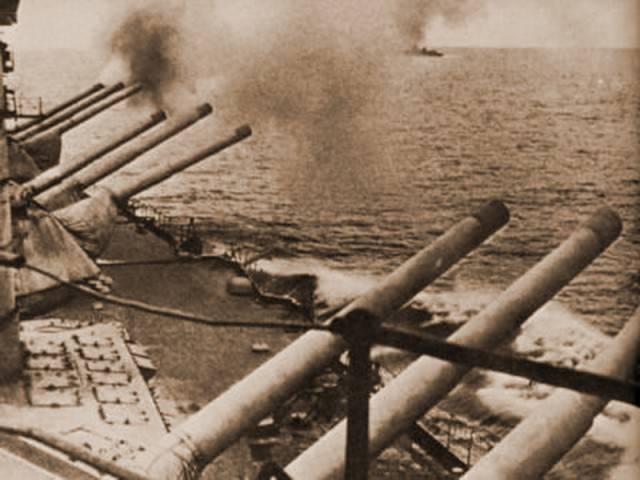
When planning the fire of the sea and field artillery, the command paid great attention to the development of a system of fixed defensive fire (LRF), mobile defensive fire (RAP) and concentrated fire (RD). Lines NZO and PZO and areas of JI, were chosen in front of the entire defense front at a distance of two to three kilometers from the front edge, and in the intended direction of the enemy offensive - and deep into our defense. The established data for firing at the specified lines and sections were checked in advance by adjustment.
So, in defensive operations, naval artillery was important. However, in its application revealed a number of shortcomings. The main one was that a large caliber was used to fire on areas that were 10-12 kilometers away, while naval guns could shoot 20-45 km. Often, coastal artillery did not set specific targets; artillery reconnaissance was not good enough; unified plans of artillery support were not developed by naval and combined-arms commanders.
The lack of field artillery ground commanders tried to fill the expense of the sea. All this led to its use with great overvoltage. There were days when each gun spent 120-300 shells, while the survivability of the barrels of naval artillery was within 600-1000 shots. The non-observance of the principle of proportionality of the power of naval artillery with the importance and value of the target negatively influenced its actions during the fire support of the ground forces. This led to the adoption of relevant orders in November 1941 on firing exclusively with the permission of the artillery headquarters of the defensive areas, fronts and armies.
In April 1942, the Chief of the General Staff gave directives on the use of naval artillery as the artillery of the Supreme Command reserve, preventing planning for such purposes that could be suppressed by the ground forces artillery. The Red Army Field Regulations, published in 1943, stated that “shipboard artillery is used mainly for hitting targets that are inaccessible to land artillery and for flanking enemy positions. Ship artillery should not be assigned tasks that require a large expenditure of shots. "
In offensive operations of naval artillery were set, as a rule, independent tasks. The most important of them were: the destruction of strongholds and fortifications in the tactical depth of the German defense, the suppression of its heavy artillery batteries, the neutralization of the work of command posts, headquarters, communications centers, inaccessible to field artillery. Also, naval artillery fire was concentrated on road junctions, enemy concentration sites, and reserves.
The general tasks of the fleet artillery were formulated in the combat orders of the artillery headquarters of the front or the army, and the firing tasks were assigned to the naval artillery headquarters, which was to control the fleet artillery groups during the period of hostilities. In all operations, the main planning document was a plan for the use of naval and coastal artillery forces, which was developed jointly by the naval and combined-arms headquarters, and based on the tasks of the combat order and the general plan for the interaction of all forces involved in the operation. The joint artillery commander of the ground forces and the fleet artillery commander or commandant of the coastal defense base participated in the preparation of the joint plan.
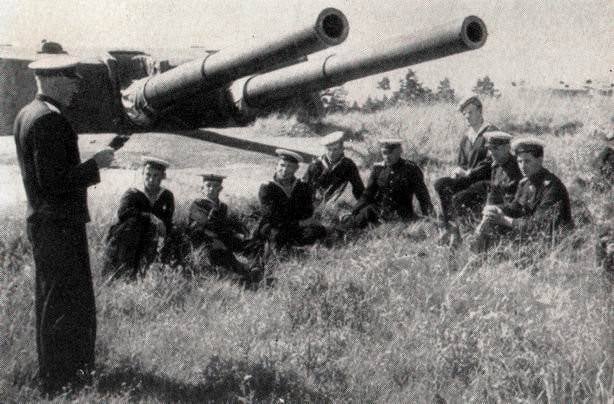
The plan clearly defined the firing tasks of the fleet artillery at the stages of the planned operation with an approximate rationing of ammunition consumption. In addition, he envisaged: the forces and means involved in artillery support; the organization of artillery and tactical intelligence; the exchange of intelligence data between the fleet and the army; the intended areas of operations of the fleet ships and coastal batteries; with what connections of the ground forces should the fleet formations or individual ships enter into communication in order to practice all the interaction issues; management organization.
The main combat document on the interaction of fleet artillery and ground forces was a planned fire table. It contained: goals, their coordinates and tasks of shelling (destruction, suppression, destruction); information on the organization of communication with ground connections, correction posts and aviation; the order of notification, calling and the end of the fire; methods of target designation, the use of conditional as well as identification signals. Planned fire tables were developed jointly by the headquarters of the commander of the artillery of ground forces and the flagship artilleryman. Artillery fire plans were usually drawn up for the next two days of the operation.
During the breakthrough of the blockade of Leningrad in January 1943, the plan for the use of fleet artillery determined its tasks to the ship and battery, inclusive. In addition, in the interests of secrecy, the main information was communicated to the performers no earlier than 5 hours before the start of the operation.
Planning was carried out somewhat differently in an operation that took place at the beginning of the 1944 year near Leningrad and Novgorod. Based on the tasks assigned, the fleet chief of artillery headquarters developed combat orders, plans for the destruction of enemy facilities during the preparatory period, and artillery support during the breakthrough period by our troops of the German defense, a map with designated coordinates of targets, and an estimated expenditure of projectiles by caliber and date. Unlike previous operations, when plans were developed up to the battery pack, only general tasks were assigned to groups of batteries. Such planning was made possible due to the increased experience of staff officers and the improvement of artillery skills. Such a planning system raised the responsibility of the commanders of artillery groups and demanded from the headquarters of the fleet artillery chief more precise and careful control in the distribution of calibers, maintaining the established firing mode, and the consumption of projectiles. In connection with the heterogeneity of the targets, and their different distances from the artillery positions, a chart was drawn up that provided for the sequential destruction of objects with various calibers. There was also a schedule for the adjustment, which was planned to be held the day before the artillery preparation. The artillery headquarters of the front and fleet compiled catalogs of German artillery firing positions, sending them to all the artillery units of the fleet.
As offensive actions developed, planned fire was replaced by firing at those points where the strongest opposition to the offensive of our units was met (at the call of military commanders). The creation of the minimum required density of artillery fire on the most important areas at the required moment was ensured by centralized control, as well as by the high-quality organization of interaction between the fleet artillery and army units. Ships and coastal batteries bombarded reserves, large concentrations of manpower and German military equipment, enemy long-range guns, destroyed targets that were significantly removed from the front edge.
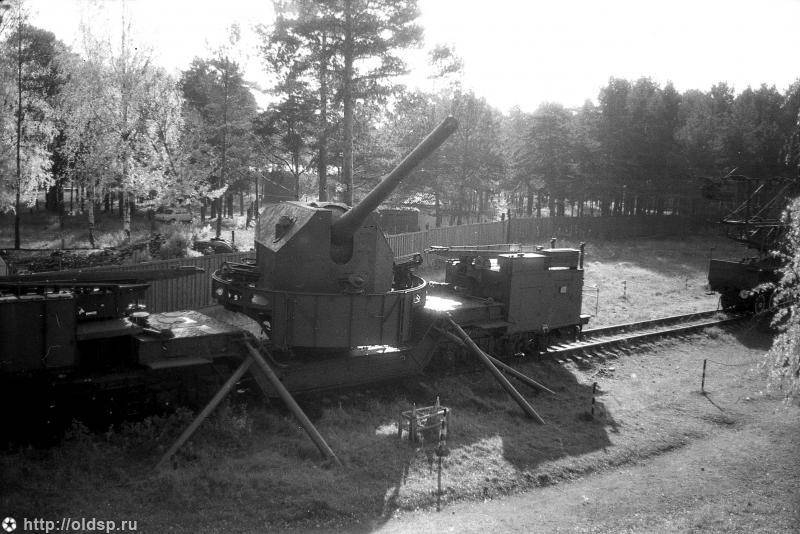
It should be said that the interaction of the artillery of the fleet and the ground forces in the period of defensive and offensive actions depended on the proper organization of control. The order of subordination in each case was established in accordance with the current situation on the shore, the sea and in the air and was drawn up by order or instruction of a higher authority. As a rule, during the defense of the naval base and during the offensive, fleet artillery control was concentrated in the hands of one artillery commander. The advantage of centralized control was that it provided an opportunity for the maximum degree of massing of art-fire in the decisive sectors of the battle. Decentralized management created the possibility of closer interaction in the areas of action units.
In the conditions of the small number of artillery in the naval base to provide effective support to the troops leading the defense, it required skillful use of it, and, first of all, a bold and quick maneuver of fire. In the defense of Tallinn, fleet artillery control was conducted from the command post of the ground defense headquarters. Challenges of fire from the command of the 10 Infantry Corps and the interacting divisions, detachments of the Marine Corps, observation and correctional posts were sent to the command post of the flagship fleet gunner, who gave instructions to the ship and coastal artillery.
During the defense of Odessa, the head of the artillery of the Maritime Army actually served as the head of the artillery of the defensive area. He had wired and radio communication with the headquarters of the artillery sectors. This communication was duplicated through the channels of general military communication. The coastal artillery was handed over to the operational subordination to the chief of artillery of the Primorye Army, and it directly locked itself in to the commandant of the coastal defense of the base, who had a direct connection with the artillery divisions. Shore battery fire was called only through the coast defense commandant. As we see, despite the fact that the stationary coastal artillery was distributed by defense sectors, it was managed centrally. The specific artillery fire missions of the naval artillery chief of the Maritime Army set through the flagship artillery detachment of ships. A similar organization was during the defense of Sevastopol.
During the defense of Leningrad, the management of the artillery of the fleet and the army was carried out by the chief of artillery of the fleet, which had its headquarters. The right to call for fire was granted only to the commander of the artillery of the Leningrad Front.
The centralized control of naval artillery in the defense of the naval base allowed it to be most expediently used, to correctly distribute tasks for artillery of various types and calibers, to mass fire, which made it possible to repel multiple enemy attacks. So, for example, on December 17, 1941 near Sevastopol, enemy infantry supported by tanks, three times tried to attack a section of the front where the 90th Infantry Regiment defended. The attacks were repelled by joint coastal and field artillery fire. At the same time, enemy units did not even have time to approach the line of our defense.
The experience of the Patriotic War clearly shows that in providing fire support to ground forces in defense and offensive, the naval and field artillery carried out close cooperation. It consisted in the distribution of objects of artillery strikes, the establishment of the sequence of their application, the definition of sectors of action, methods of mutual information, the appointment of common signals, the organization of communication interaction.
The interaction of all types of artillery was provided by the advance planning of its fire and maneuver and was maintained by flexible control during the battle. The implementation of continuous interaction required a high degree of organization, clarity and coherence in the actions of the command and staffs at all levels, and the precise fulfillment of duties by all gunners.
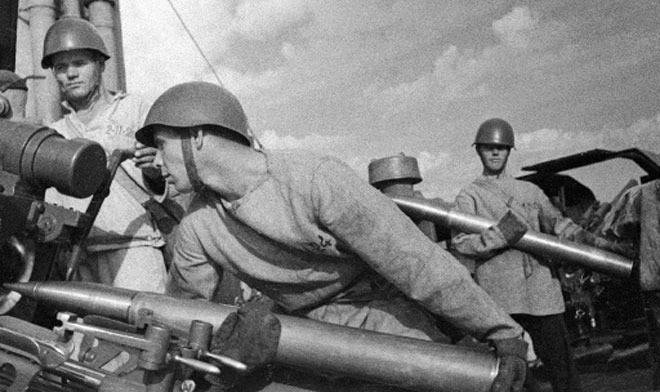
In the organization of interaction, the correct distribution of tasks between the naval and field artillery was of great importance, the solution of which made it possible to maximize the use of each type of artillery in the maximum accordance with its properties. Experience has shown that, while retaining the necessary independence and solving a common task, sea and field artillery should not replace each other. A clear delineation and mutual coordination of tasks ensured the achievement of the greatest results.
Sources:
Achkasov V., Pavlovich H. Artillery support for ground forces // Soviet naval art in the Great Patriotic War. M .: Voenizdat, 1973. C.178-199.
Morozov M., Kuznetsov A. The Black Sea Fleet in the Great Patriotic War. Short course of fighting. M .: Yauza Press, 2015. C. 43-56.
Perechnev Y. Soviet coastal artillery: History development and combat use of 1921 – 1945. M .: Science, 1976. C. 83-122, 148-188
Perechnev, Y. Interaction of naval and field artillery. // visage 1974. No.6. C. 39-46.
Orlov V. Ensuring the interaction of naval and field artillery in the operations of the Great Patriotic War. // Sea collection. 1983. No.7. C. 57-63
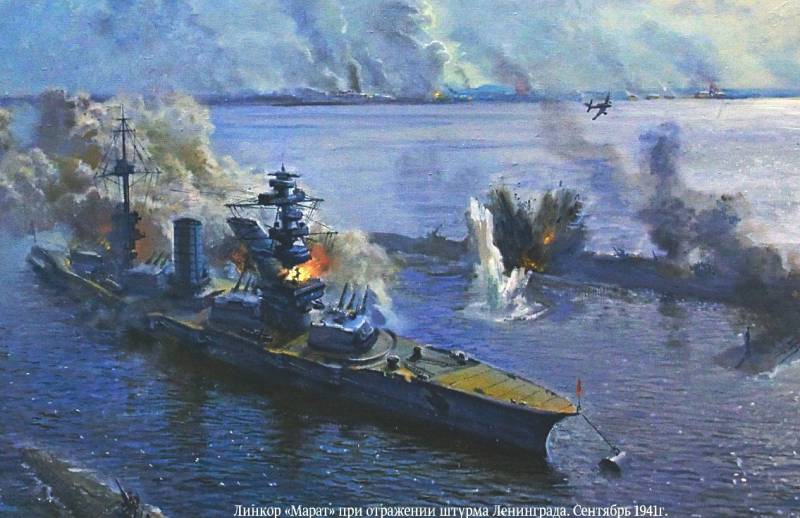
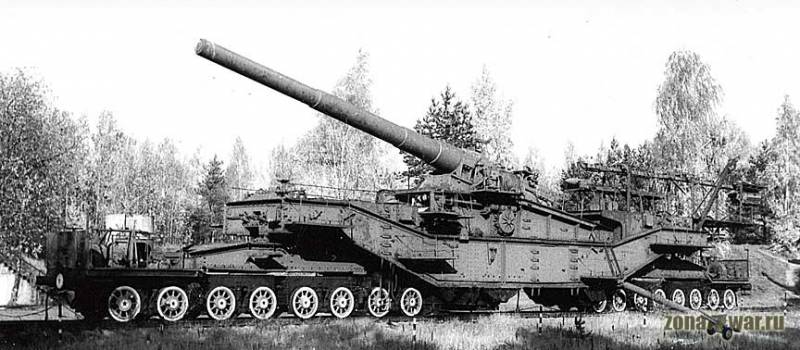
Information